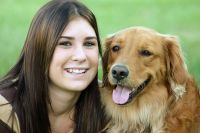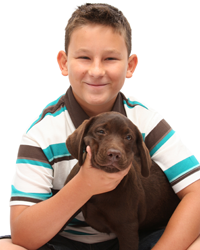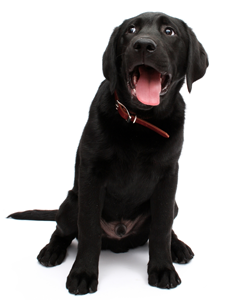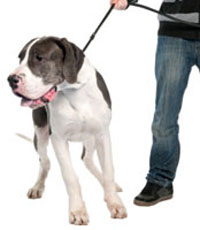Dog Training With Hand Gestures
Dogs Respond Well to Hand Gestures
Dogs rely heavily on physical cues to communicate. They also watch their owners for similar cues. Early training provides an example of how gestures can contribute to training: Trainers will pat their left legs to bring dogs into the “heel” position or gesture toward the floor to demonstrate that she should lie down. Dogs will often understand gestures first and will pair the spoken command with the action later.
Beginning Training with Hand Gestures
Human beings rely on spoken words to communicate, so our gestures are not always crisp or directed. During early training, hand gestures should be broad and slow. Gesture speed can increase as the dog becomes more familiar with the command. Training your dog to lie down should start with the dog at the trainer’s side. The gesture should start in front of her nose, proceed to her chest and sweep down and forward along and past her forelegs. Her body will follow the motion of her head, causing her to lie down. Similarly, when training her to sit, the hand gesture should begin in front of her nose and sweep up over her forehead. As she looks up, her bottom will approach the floor.
Advanced Training with Hand Gestures
Dogs are not often taught to stand, but this command is useful at the veterinarian’s office or groomers. The stand is often taught, beginning with the dog in the sitting position, by the trainer placing his palm horizontally in front of the dog’s nose and drawing the hand forward. The gesture for the stay command consists of the trainer placing his or her palm in front of the dog, fingers facing downward. Because all previous signals have told the dog to do something with her body, this signal can be difficult to teach.
Hand Gestures at a Distance
Gestured commands are useful at a distance. These gestures also need to be broad to be seen from far away. The hand gesture for come involves the trainer bringing his hand up and sweeping it in front of his body to touch his chest with his palm. This gesture mimics reeling the dog in with the leash while teaching the dog to come during early training. The gestures for stop and down are different at a distance than at the trainer’s side. The gesture for “stop” at a distance is the arm held out in front of the trainer, palm out, fingers facing upward. The gesture for down consists of the trainer raising his hand above his head and swinging it down toward the ground.
Gun Dog Training Tips for Retrievers
Basic Obedience
Don’t train your dog as a gun dog until it has completed basic obedience. In the field, your dog needs to know how to stay by your side off its leash. It should return to you without hesitation when you call or after retrieving a bird. For safety reasons, you also need to know that your dog will sit, lie down and stay at your command. Enroll your dog in basic, intermediate and then advanced obedience classes to help it get a good foundation in obedience. Practice these skills daily at home, both in formal training sessions and by incorporating the commands into your dog’s daily routine. Start this training when your gun dog is still a puppy.
Training Retrieve
Retrieving is a Labrador or golden retriever’s favorite thing to do. Start this training as soon as you get your gun dog home. Purchase retrieving dummies. Hold your puppy back with one hand on its chest, and show it the dummy. Toss the dummy no more than a few feet away, and release your puppy as you give a verbal command such as “fetch,” “retrieve” or “get it.” Start this training in a hallway so that your puppy has no choice but to return to you. Praise it each time it does. Ask your puppy to drop it. Again, reward your puppy with praise and a treat if it gives the dummy back to you without a fight. Gradually increase the length of your throws, and start practicing in outdoor environments as your puppy gets better and better at retrieving.
Field Conditioning
You can’t train your gun dog at home, take it hunting one day and expect it to perform. Even though they were bred for this task, retrievers need a chance to get used to the sights, sounds and smells they will experience in the field. Take your puppy out as often as you can as it grows up. Keep it on a leash at first, especially if it is still working on basic obedience. Expose your puppy to the sounds of gunfire, the marshes it will be working in, other dogs that will be hunting with you and the sight and smell of real birds. Take treats along on each outing, and reward your gun dog when it remains calm despite the exciting (or frightening) surroundings. Start practicing your dog’s retrieve in the field a little at a time.
Train in the Offseason
Retrievers will forget commands and skills if they aren’t practiced. Even after hunting season ends, practice with your dog in your yard and take it to the field whenever you can. Keep practice sessions short. They should last only five to 10 minutes for an adult retriever. If they are any longer, your retriever could get bored and distracted. In addition to retrieving, keep your dog up-to-date on its basic obedience skills. Include commands such as “sit” and “stay” in its daily routine. Take it on walks to secluded areas where you can let it off the leash. If it gets used to being confined, it might wander off when hunting season finally does come around. Off-leash, retrieving and basic obedience skills should all be practiced year-round.
Coon Dog Training
1Begin training your dog with basic commands such as sit, stay and heel. Use a system of positive reinforcement through dog treats, petting and verbal praise to encourage obedience in the dog. The dog must first learn to obey you in general before he can learn to hunt raccoons.
2Choose a command for entering your car, such as “load up” or “get in.” Train the puppy to go to your car or truck and to be comfortable in his dog box or in the back of your vehicle. The more comfortable the dog becomes with transportation, the more prepared he will be for the hunt.
3Lay artificial scents in areas of your yard or small wooded areas. Encourage your dog to follow these scents; this will get him used to the scent of a raccoon, as well as give him practice following trails. Reward the dog for following the scent properly.
4Use an old coon hide to teach your dog what the raccoon looks like. Drag it in front of the dog as he chases it so that he gets used to following the raccoon. Hang the hide from trees so that the dog gets used to staying with the raccoon even after it climbs. Reward the dog for following and pursuing the coon hide.
5Arrange for your new coon dog to go on hunts with experienced raccoon hunting dogs. The younger animal will mimic the experienced dog’s actions and abilities and will pick up a lot of techniques from the older dog.
Spend Quality Time with Your Dog

The dog’s owner is a busy guy. He’s got a full-time job, a house to maintain, and all the other tasks to perform that go with life today. I sympathize: 21st century life can be chaotic for anyone. But we can make time for our dogs without exerting very much effort or spending a lot of extra time. Here are some ways to do just that.
Take her along. Whether running errands, picking the kids up from school, or stopping by your office, including your dog can be a hassle-free way to give her attention and stimulation. “For adult dogs whose owners’ lifestyles primarily revolve around being home, at soccer games, and ferrying the kids to school, having the dog participate in these activities can meet much of her social needs,” says Alice Moon-Fanelli, Ph.D., certified applied animal behaviorist at the Cummings School of Veterinary Medicine at Tufts University.
Sleep with her. Experts agree that having your dog sleep in your bedroom, but not necessarily on your bed, can be a great way to spend extended time with your canine companion with no additional effort on your part. You sleep, she sleeps. What could be easier?
Find things you both like to do. Some activities you do for your own enjoyment are even more fun if your four-legged friend does them with you. Moon-Fanelli recommends spending some one-on-one time with your dog “in mutually enjoyable physical activities,” such as swimming and hiking.
Try multi-tasking. Are you busy fixing lunch or preparing dinner while your dog hangs around? Use this opportunity to help her practice sit-stays and down-stays. Are you watching TV? Use that time to brush your best friend, too — or at least give her some cuddle-time.
Do some delegating. If you don’t live alone, other family members can help out with dog care. For example, “when there are children in the household, they can become the designated walkers, exercisers, and players,” notes Terry Curtis, DVM, veterinary behaviorist at the University of Florida in Gainesville. “It just spreads the interactions over more people.”
That said, you do need to at least spend a little extra time with your dog if she’s to become a happy member of your household and stay that way. Every dog needs training, exercise, and some one-on-one time with her people each day. A little creativity on your part can go a long way toward meeting those needs without putting much of a dent in your schedule.
Vigilance is Key to Preventing a Bite

The AVMA estimates that of the children under the age of 18 who have been bitten: family dogs are responsible for 30% of the bites, while the neighbor’s dog is responsible for another 50% of the bites. Never assume because the child and dog know each other that they are fine together.
Whether you have a dog or not, take a minute to read over these helpful tips to preventing dog bites from Heidi Ganahl, CEO and founder of Camp Bow Wow. We all encounter dogs almost daily.These 10 tips might just save you a trip to the hospital. It might also save your dog’s life – many times an offending dog will be euthanized.
Pet Personalities. Dog owners should always understand (through training) their dog’s personality and limitations. Owners should not put dogs into situations where they feel anxious, nervous or afraid – this is a recipe for a dog bite encounter. Most aggression is fear-based and most bites are preventable if the owner takes some time to understand their dog.
Pets and Socialization. Socialize your pet at early stages in his development. This will allow your pet to feel at ease around people and other animals in social settings. Socializing your dog can have a tremendous effect on his interactions both at home and in public. Newly socialized dogs become calmer, friendly, affectionate, and can adapt better to a new environment.
Training Techniques. Train your dog or hire a professional to do so. Basic commands such as “Sit” and “Stay” help dogs understand what is expected of them. Training can also be incorporated into fun activities that establish the owner as an authoritative figure, yet strengthen the bond between owner and dog as companion and friend.
Space and Body Language. Respect the dog’s space. Never stand over a dog or stare at the dog while hovering above him. This is a direct threat in the dog’s language and may provoke a bite because the dog is afraid or intimidated.
Pets and Children. Children are the most common victims of dog bites. Never leave a child under 10 years old alone with a dog, no matter how much you trust your four-legged friend. Children should always ask before petting a dog, and parents and dog owners should observe and supervise the interaction between dog and child with even the most child-friendly dog.
Children and Aggressive Behavior. Children should never get in a dogs face or grab the dog in an aggressive way. Dogs tend to give warnings when they are uncomfortable and may bite in response. In most cases, children aren’t able to pick up on these signals and can easily get hurt.
Dogs in Chains. Never chain or tether your dog in the backyard or any other area. Dogs who are chained up feel increased levels of stress and protectiveness. A dog that is confined and feels threatened will defend himself and is more likely to bite.
Security in Public. Pet owners should always use a leash to ensure that they are able to control their dog in public settings. If the pet becomes excited or anxious for any reason, pet owners should draw him near and gently pat his head or rub his fur to calm him down.
Security at Home. If your home has a fenced yard, make sure gates are always secure. This will prevent Fido from running off into public spaces and interacting with others without your supervision.
Pet Health. A healthy pet is a happy pet. Make sure that your dog visits a veterinarian annually, receives proper exercise, and is vaccinated against rabies and preventable diseases. Remember, how your dog feels affects how he behaves.
View the DogChannel behavior center for more signs and corrective actions for dog’s that bite. More>>
The following are tips provided by the CDC on what to do if you or your child is bitten:
Rinse the bite area with soapy water.
Elevate limb(s) that have been bitten.
Apply antiseptic lotion or cream. Watch the area for signs of infection for several days after the incident.
For deeper bites or puncture wounds, apply pressure with a clean bandage or towel to stop the bleeding. Then wash the wound, dry it and cover with a sterile dressing. Don’t use tape or butterfly bandages to close the wound.
It’s a good idea to call your child’s physician because a bite could require antibiotics or a tetanus shot. The doctor also can help you to report the incident.
If your child is bitten severely, call 9-1-1 or go to the emergency room.
When going to the emergency room, advise the personnel of:
a. your tetanus vaccination status
b. vaccine status of the dog
c. who the dog owner is; and
d. if the dog has bitten before
Remember, vigilance is key in any situation where your dog is around other people and animals. Never assume you know what your dog is going to do – that’s like assuming you know what the person next to you is thinking or going to do – it’s a recipe for disaster.
Dog Peeing When Excited

It is fairly common in young puppies who have less control over their bladder and are easily excited, though it usually goes away as the dog matures. Some dogs, however, continue this habit into adulthood. This behavior tends to be more common in female pups, but it can happen with males, too.
Why dogs pee when excited
When a puppy becomes overexcited, or when something frightens her, it’s normal for the pup to release a few drops of urine. Not all puppies do this, but many do. It happens because overexcitement or fear may cause the pup to momentarily lose control of the muscles that close the urinary bladder, which allows a small amount of urine to escape.
This is a physiological response to excitement and is not under the pup’s control. She might not even realize it’s happening until she feels a sensation of wetness.
Why this dog behavior is a problem
Cleaning up puddles every time you greet your dog can be frustrating and distressing to owners. The first reaction is often to scold a dog for the behavior, but it is not the dog’s fault. Punishing a dog for this behavior is useless and cruel, because the dog cannot control the leakage.
Scolding or showing disapproval can make the dog more anxious and cause the problem to get worse – sometimes turning a temporary age or health-related behavior into a long-term nervous habit.
How to keep your dog from peeing when excited
Reduce the initial excitement. The most common trigger for urination while greeting is loved ones arriving home after being gone for several hours. To reduce the dog’s excitement, walk into your house without greeting her. Put down your purse or other items you’re carrying and put your coat away. Delay greeting her until about five minutes after you’ve arrived home.
Keep greetings low key. Speak quietly and calmly when you greet your dog. Don’t immediately bend down to pet her, as “looming over” a dog in that way can trigger them to urinate. Instead of reaching for her, just put your hand where she can come to it for petting. Pet her under the chin, not on top of the head. Teach your visitors to do the same.
Greet outdoors. If your dog tends to pee when you first say hello to her, say hello outdoors. This way the dog will be urinating where there’s no need to mop it up. That will reduce your own anxiety about the possibility of a wet greeting and you’ll relax a bit – which can help reduce any anxiety your dog might have learned to feel about greeting time.
Health check. Though usually outgrown by six or seven months of age, this behavior can linger into adulthood. Sometimes health issues, such as urinary tract infections, can cause delayed bladder control, so if your dog is over five months old and still piddling when petted, let your veterinarian know. If it’s a health problem, it needs to be treated medically. Most often, though, there are no health issues causing the problem – it’s just a case of too much excitement.
Dog Pulling on Leash

A dog pulls on the leash for several reasons:
• Sees, hears, or smells something exciting.
• Excess energy makes it hard for her to contain herself.
• Through experience, realizes that pulling on leash makes the handler walk faster or go the direction she wants.
• Because she can.
Why this dog behavior is a problem
Pulling on leash can start off innocently, but can become a problem for both the dog and the handler. The added pressure of the collar against the dog’s windpipe (trachea) can cause wheezing or coughing, which may be only temporary, or may cause long-term or even permanent damage to the dog. A dog who pulls strongly can cause the handler to lose balance and slip or fall. Strong leash pulling by a large dog, especially near roads with traffic, can lead to serious accidents.

Changing from a neck collar to either a head halter or front-attachment body harness can bring an immediate solution to leash pulling. These tools provide a mechanical advantage for the handler and do not cause pain for the dog. Using a head halter or front-attachment harness immediately allows the handler to control the direction and speed of the dog, without needing a lot of physical strength to accomplish this, but the dog still needs to learn how to walk politely, without pulling at all.
Teaching your dog to walk on a leash
A good way to teach loose-leash walking to a dog who pulls on the leash is to show her that pulling no longer “works” they way she thinks it will. When your dog starts to pull, simply stop walking. Stand still and wait for your dog to realize she’s not getting anywhere.
If your dog continues to pull after you’ve been stopped for three seconds, start very slowly walking backwards. Your dog will realize she’s losing ground now, not gaining it. When the dog turns around to look at you, wondering what’s gone wrong at your end of the leash, the leash will loosen a little bit. At that point, you can praise her and start walking forward again.
By consistently repeating this process each time she pulls, she will start to realize that pulling activates your “brakes” and not your “accelerator,” and the frequency of pulling will gradually diminish and eventually disappear.
Once your dog understands how to walk without pulling when wearing a head collar or body harness, you’ll be able to re-introduce her to walking politely while wearing an ordinary collar.





